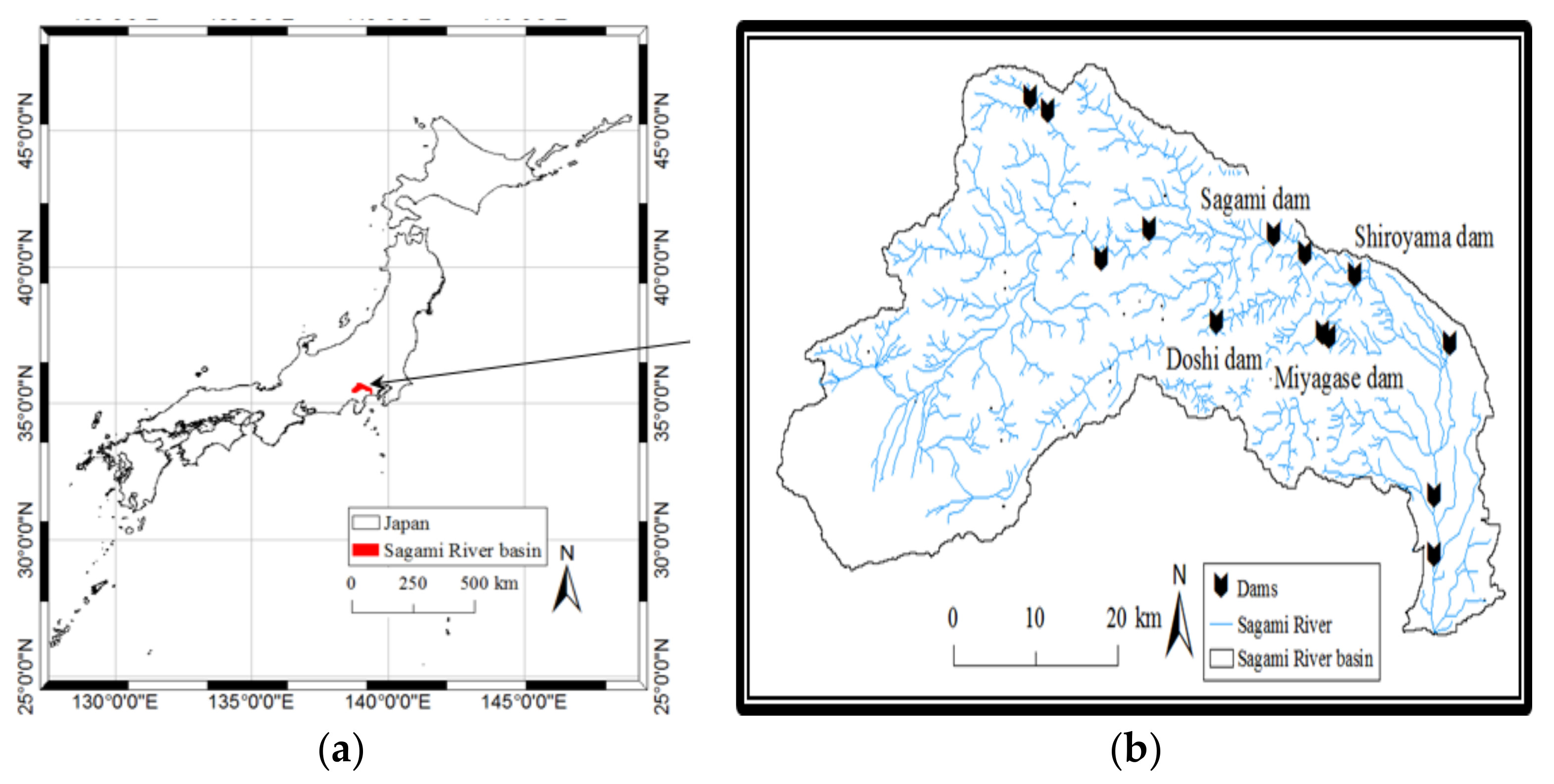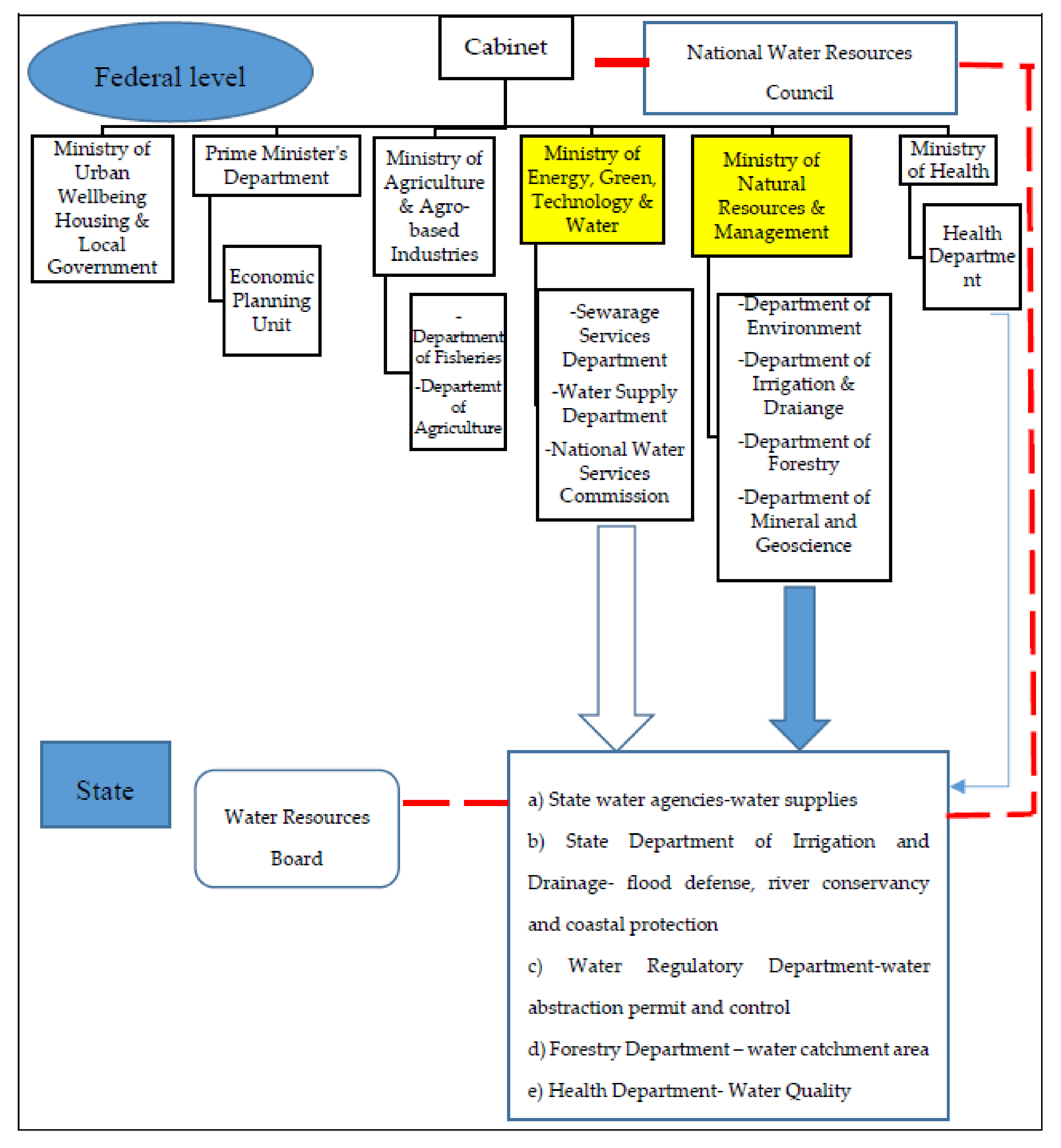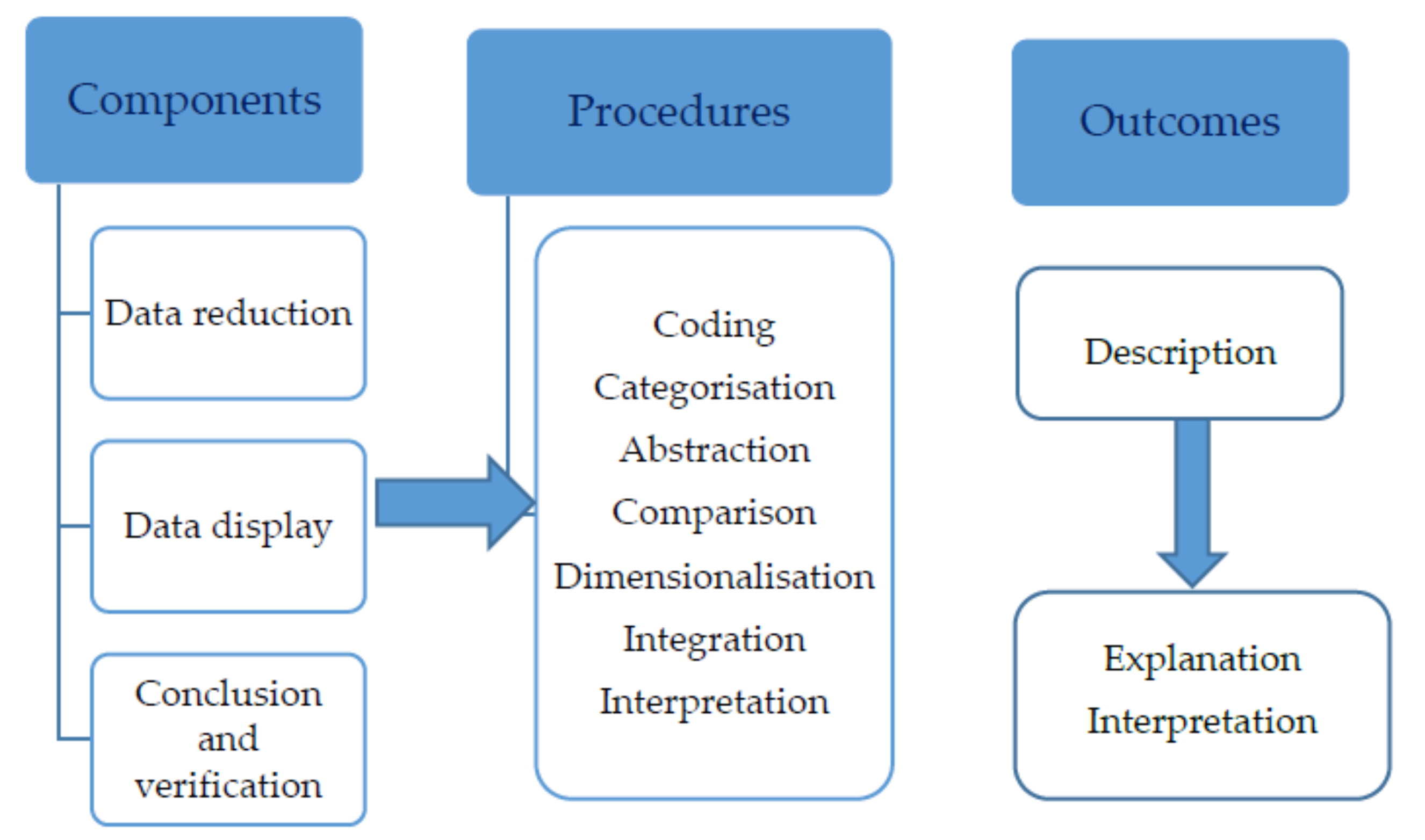Comparative Research on River Basin Management in the Sagami River Basin (Japan) and the Muda River Basin (Malaysia)
Abstract
:1. Introduction
1.1. IWRM and PES
1.2. Research Aim and Research Questions
- Who are the key stakeholders relevant to the water resource governance in the Sagami River Basin and the Muda River Basin?
- Which factors would support the successful implementation of the Integrated Water Resource Management (IWRM) in the river basin?
- What are the PES lessons learned from the Sagami River Basin and how can they be applied to improve the management of the Muda River Basin in Malaysia?
2. Study Area
2.1. Study Area 1: Sagami River Basin
2.2. Study Area 2: Muda River Basin
2.3. Features of the Selected Basins
3. Materials and Methods
3.1. Selection of Target Group
3.2. Data Collection
3.3. Data Analysis
4. Results and Discussion
- a legal and institutional framework to ensure sustainable and predictable funding from beneficiaries (Yokohama City in Kanagawa) to Doshi-mura in Kanagawa for managing the forests at the upstream of Sagami river basin;
- institutional and technical capacity to implement proper forest management;
- benefit sharing with local communities to support their livelihoods and ensure their contribution to forest management;
- the promotion of awareness-raising among beneficiaries (citizens of Kanagawa, especially citizens of Yokohama, as 80% of the city comes from headwater that is located at the forest of Doshi-mura) of the environmental services provided by Doshi-mura forest in Yamanashi.
5. Conclusions
Author Contributions
Acknowledgments
Conflicts of Interest
References
- UNEP, UD. Transboundary River Basins: Status and Trends; United Nations Environment Programme (UNEP): Nairobi, Kenya, 2016; Available online: http://www.geftwap.org/publications/river-basins-spm (accessed on 10 April 2018).
- Sadoff, C.W.; Grey, D. Beyond the river: The benefits of cooperation on international rivers. Water Policy 2002, 4, 389–403. [Google Scholar] [CrossRef]
- Gleditsch, N.P.; Furlong, K.; Hegre, H.; Lacina, B.; Owen, T. Conflicts over shared rivers: Resource scarcity or fuzzy boundaries? Political Geogr. 2006, 25, 361–382. [Google Scholar] [CrossRef]
- De Stefano, L.; Svendsen, M.; Giordano, M.; Steel, B.S.; Brown, B.; Wolf, A.T. Water governance benchmarking: Concepts and approach framework as applied to Middle East and North Africa countries. Water Policy 2014, 16, 1121–1139. [Google Scholar] [CrossRef]
- Cook, B.R.; Spray, C.J. Ecosystem services and integrated water resource management: Different paths to the same end? J. Environ. Manag. 2012, 109, 93–100. [Google Scholar] [CrossRef] [PubMed]
- Hooper, B.P. Integrated water resources management and river basin governance. Water Resour. 2003, 126, 12–20. [Google Scholar]
- Implementing Integrated Water Resources Management (IWRM): Based on Thailand’s Experience. Available online: https://cmsdata.iucn.org/downloads/implementing_iwrm__rm_changes_130510___2_.pdf (accessed on 16 June 2016).
- Berkes, F.L.; Folke, C.; Colding, J. Linking Social and Ecological Systems: Management Practices and Social Mechanisms for Building Resilience; Cambridge University Press: Cambridge, UK, 1998. [Google Scholar]
- Folke, C.; Hahn, T.; Olsson, P.; Norberg, J. Adaptive governance of socioecological systems. Annu. Rev. Environ. Resour. 2005, 30, 441–473. [Google Scholar] [CrossRef]
- Huitema, D.; Mostert, E.; Egas, W.; Moellenkamp, S.; Pahl-Wostl, C.; Yalcin, R. Adaptive water governance: Assessing the institutional prescriptions of adaptive co-management from a governance perspective and defining a research agenda. Ecol. Soc. 2009, 14, 26. [Google Scholar] [CrossRef]
- Pahl-Wostl, C.; Sendzimir, J.; Jeffrey, P.; Aerts, J.; Berkamp, G.; Cross, K. Managing change toward adaptive water management through social learning. Ecol. Soc. 2007, 12, 30. [Google Scholar] [CrossRef]
- Yashiro, M.; Duraiappah, A.; Kosoy, N. Chapter 10: A nested institutional approach for managing bundled ecosystem services: Experience from managing Satoyama landscapes in Japan. In Governing the Provision of Ecosystem Services; Rival, L., Muradian, R., Eds.; Springer: London, UK, 2013; pp. 191–206. [Google Scholar]
- Schomers, S.; Matzdorf, B. Payments for ecosystem services: A review and comparison of developing and industrialized countries. Ecosyst. Serv. 2013. [Google Scholar] [CrossRef]
- Wunder, S. Payments for Environmental Services: Some Nuts and Bolts, Center for International Forestry Research Occasional Paper No. 42; Center for International Forestry Research: Bogor Barat, Indonesia, 2005. [Google Scholar]
- Japan International Cooperation Agency (JICA). Japan’s Experiences on Water Supply Development. March 2017. Available online: https://www.jica.go.jp/english/our_work/thematic_issues/water/c8h0vm0000ammj2q-att/activity_01.pdf (accessed on 30 October 2016).
- Kagombe, J.K.; Kungu, J.; Mugendi, D.; Cheboiwo, J.K. Evaluating the Willingness to Pay for Watershed Protection in Ndaka-ini Dam, Muranga County, Kenya. 2018. Available online: https://www.researchgate.net/profile/Joram_Kagombe/publication/322861627_Evaluating_the_Willingness_to_Pay_for_Watershed_Protection_in_Ndakaini_Dam_Muranga_County_Kenya/links/5a732629458515512076cf23/Evaluating-the-Willingness-to-Pay-for-Watershed-Protection-in-Ndaka-ini-Dam-Muranga-County-Kenya.pdf (accessed on 1 April 2018).
- Mokhtar, M.B.; Tan, K.W. Integrated Water Resources Management in Malaysia: An Effective Institutional Framework; Institute for Environment and Development (LESTARI), National University of Malaysia, UKM Bangi: Bangi, Malaysia, 2004. [Google Scholar]
- Terakawa, A. Integrated flood management for urbanized river basin in Japan. In Proceedings of the World Water Forum: Local Actions for a Global Challenge, Mexico City, Mexico, 16–22 March 2006; pp. 1–36. [Google Scholar]
- Nakai, M. The Outline of the River Law NARBO Associate, Asian Development Bank Institute. 2001. Available online: http://www.narbo.jp/narbo/event/materials/twwa03/tw03_09_01-2.pdf (accessed on 20 November 2016).
- River Bureau of the Ministry of Land, Infrastructure, Transport, and Tourism Efforts to Prevent Urban Flood Disaster in Japan, 9 June 2008. Available online: http://www.mlit.go.jp/river/basic_info/english/pdf/conf_07.pdf (accessed on 27 May 2016).
- World Water Assessment Programme (United Nations). Water: A Shared Responsibility (Volume 2). Berghahn Books. Available online: http://unesdoc.unesco.org/images/0014/001454/145405e.pdf (accessed on 19 September 2016).
- Yoshimura, C.; Omura, T.; Furumai, H.; Tockner, K. Present state of rivers and streams in Japan. River Res. Appl. 2005, 21, 93–112. [Google Scholar] [CrossRef]
- World Bank. Water Resources Management in Japan-Policy, Institutional and Legal Issues. In Analytical and Advisory Assistance (AAA) Program, China: Addressing Water Scarcity, Background Paper 1; The World Bank: Washington, DC, USA, 2006. [Google Scholar]
- Ministry of Land and Transport. Water Resources of Japan; Ministry of Land and Transport: Tokyo, Japan, 2009.
- Chakraborty, A. Developing Rivers: How Strong State and Bureaucracy Continue to Suffocate Environment-Oriented River Governance in Japan. SAGE Open 2013, 3. [Google Scholar] [CrossRef]
- Latief, S.S. Water Supply and JICA’s Role in Eastern Indonesia (3), Turn the Tap and Drink the Water. Fajar Daily. 15 November 2010. Available online: https://www.jica.go.jp/topics/2010/pdf/20101213_02_indonesia.pdf (accessed on 1 November 2016).
- National Land Numerical Information Download Service Rivers, Basin Mesh, Dams, Elevation, Degree of Slope 5th Mesh Data. Available online: http://nlftp.mlit.go.jp/ksj-e/index.html (accessed on 22 May 2017).
- Ministry of Land, Infrastructure, Transport and Tourism, Water Resources in Japan. 2008. Available online: https://www.mlit.go.jp/tochimizushigen/mizsei/water_resources/contents/policy.html (accessed on 30 October 2016).
- Chan, N.W.; Ibrahim, A.L.; Hajar, A.R. The role of Non-Governmental Organisations in water resources management in Malaysia. In Proceedings of the Regional Symposium on Environment and Natural Resources, Kuala Lumpur, Malaysia, 10–11 April 2002. [Google Scholar]
- Sim, L.M.; Chan, N.W.; Ao, M. Stakeholders’ Participation in Sustainable Water Resource Management, Lessons from Tsurumi River for Muda River Basin. New Water Policy Pract. 2015, 2, 51–62. [Google Scholar]
- Chan, N.W. Pembangunan, Pembandaran Dan Peningkatan Bahaya Dan Bencana Air Di Malaysia: Isu, Pengurusan Dan Cabaran; Penerbit Universiti Sains Malaysia: Penang, Malaysia, 2002. [Google Scholar]
- Chan, N.W. A critical review of Malaysia’s accomplishment on water resources management under AGENDA 21. Malays. J. Environ. Manag. 2004, 5, 55–78. [Google Scholar]
- Ti, L.H.; Façon, T.G. Malaysia’s Water Vision: The Way Forward-the Malaysian Water Partnership in From Vision to Action: A Synthesis of National Water Visions in Southeast Asia. In The FAO-ESCAP Pilot Project on National Water Visions; Food and Agriculture Organization of the United Nations: Bangkok, Thailand, 2002; pp. 25–42. [Google Scholar]
- Rahman, S.A.; Khalid, R.M. Water Resource Management in Malaysia: Legal Issues and Challenges. Int. J. Sustain. Dev. Plan. 2009, 4, 258–264. [Google Scholar] [CrossRef]
- Richards, D.; Smith, M. Governance and Public Policy in the UK; Oxford University Press: Oxford, UK, 2003. [Google Scholar]
- Abidin, N.A.Z. Holistic Management of Water Resources in Malaysia, Water Supply Department, KeTTHA. 2015. Available online: http://www.mwa.org.my/pdf/bwwe2015/keynote/Keynote%201%20-%20Hj.%20Noor%20Azahari.pdf (accessed on 30 October 2016).
- DID; JICA. Comprehensive Management Plan of Muda River Basin–Final Report. Government of Penang Gazette. 1995. Available online: http://open_jicareport.jica.go.jp/pdf/11253218_01.pdf (accessed on 1 October 2015).
- Azhar, M. Managing Malaysian water resources development. J. Kesihat. Masy. 2000, 6, 40–58. [Google Scholar]
- Abidin, R.Z.R.Z. Water resources management in Malaysia: The way forward. Presented at the Asia Water 2004, Kuala Lumpur, Malaysia, 30 March–2 April 2004. [Google Scholar]
- Nor ‘Aini Abdul Wahab. Overview of the Water Services Industry in Malaysia (Powerpoint Slides), Ministry of Energy, Green and Technology and Water, Malaysia. 2011. Available online: http://www.mlit.go.jp/common/000135515.pdf (accessed on 2 April 2016).
- Yin, R.K. Case Study Research—Design and Methods; Applied Social Research Methods Series; SAGE Publications: Thousand Oaks, CA, USA, 2003. [Google Scholar]
- Patton, M.Q. Qualitative Evaluation and Research Methods, 2nd ed.; Sage Publications: London, UK; New Delhi, India, 1990. [Google Scholar]
- Thomas, G. A typology for the case study in social science following a review of definition, discourse, and structure. Qual. Inq. 2011, 17, 511–521. [Google Scholar] [CrossRef]
- Wedawatta, G.; Ingirige, B.; Amaratunga, D. Case Study as a Research Strategy: Investigating Extreme Weather Resilience of Construction SMEs in the UK; School of the Built Environment, the University of Salford: Salford, UK, 2011. [Google Scholar]
- Edwards, R.; Holland, J. What Is Qualitative Interviewing; A&C Black, 2013. Available online: http://eprints.ncrm.ac.uk/3276/1/complete_proofs.pdf (accessed on 7 April 2018).
- Punch, K.R. Introduction to Social Research: Quantitative and Qualitative Approaches; Sage: Thousand Oaks, CA, USA, 1998. [Google Scholar]
- International Union for Conservation of Nature. Indigenous Peoples and Sustainability. Cases and Actions. IUCN InterCommission Task Force on Indigenous Peoples. In IUCN Indigenous Peoples and Conservation Initiative International Books; IUCN: Utrecht, The Netherlands, 1997; p. 162. [Google Scholar]
- Blomquist, W.; Giansante, C.; Bhat, A.; Kemper, K. Institutional and Policy Analysis of River Basin Management in the Guadalquivir River, Spain; Policy Research Working Paper; The World Bank: Washington, DC, USA, 2004. [Google Scholar]
- Formiga-Johnsson, R.M.; Kemper, K. Institutional and Policy Analysis of River Basin Management in the Jaguaribe River, Brazil; Policy Research Working Paper; The World Bank: Washington, DC, USA, 2005. [Google Scholar]
- Patton, M.Q. Qualitative Research and Evaluation Methods, 3rd ed.; Sage Publications: Thousand Oaks, CA, USA; London, UK; New Delhi, India, 2002. [Google Scholar]
- Cresswell, J.W.; Clark, V.L.P. Designing and Conducting Mixed Method Research; Sage: Thousand Oaks, CA, USA, 2007; p. 273. Available online: https://onlinelibrary.wiley.com/doi/pdf/10.1111/j.1753-6405.2007.00097.x (accessed on 23 May 2018).
- Sensing, T. Qualitative Research. A Multi-Methods Approach to Projects for Doctor of Ministry Theses; Wipf & Stock: Eugene, OR, USA, 2011. [Google Scholar]
- Neuman, W.L. Basics of Social Research: Qualitative and Quantitative Approaches; Pearson Education, Inc.: Boston, NY, USA, 2004. [Google Scholar]
- Sarantakos, S. Social Research; Palgrave Macmillan: London, UK, 2012. [Google Scholar]
- Mikkelsen, B. Methods for Development Work and Research—A Guide for Practitioners, 2nd ed.; SAGE Publication: London, UK, 2005. [Google Scholar]
- Bazeley, P. Qualitative Data Analysis with Nvivo; Sage Publication Inc.: Thousand Oaks, CA, USA, 2010. [Google Scholar]
- Bryman, A.; Teevan, J.; Bell, E. Social Research Methods, 2nd ed.; Oxford University Press Inc.: Don Mills, ON, Canada, 2009. [Google Scholar]
- Kvale, S. Interview: An Introduction to Qualitative Research Interviewing; SAGE Publications Inc.: Thousand Oaks, CA, USA, 1996. [Google Scholar]
- Miles, M.B.; Huberman, A.M. Qualitative Data Analysis: An Expanded Sourcebook, 2nd ed.; Sage: Thousand Oaks, CA, USA, 1994; pp. 10–11. [Google Scholar]
- Spiggle, S. Analysis and interpretation of qualitative data in consumer research. J. Consum. Res. 1994, 21, 491–503. [Google Scholar] [CrossRef]
- Melissa, D.C. Kedah’s Padi Hindering Progress. New Straits Times. 4 October 2016. Available online: http://www.nst.com.my/news/2016/10/177861/kedahs-padi-fields-hindering-progress?d=1 (accessed on 18 February 2017).
- Himiyama, Y. Regional Sustainable Development Review: Japan; Eolss Publishers Co., Ltd.: Oxford, United Kingdom, 2009; pp. 237–242. [Google Scholar]
- Hayashi, K.; Nishimiya, H. Good practices of payments for ecosystem services in Japan. In EcoTopia Science Institute Policy Brief; Revised in October 2010; Nagoya, Japan, 2010. Volume 1. Available online: http://www.esi.nagoya-u.ac.jp/eng/publications/ESI%20IGES%202011april%20re%20for%20web.pdf (accessed on 12 April 2018).



| Concerned Organization | Tasks | Sub-Section | Main Laws |
|---|---|---|---|
| Ministry of Health, Labour, and Welfare | Water supply |
|
|
| Ministry of Agriculture, Forestry, and Fisheries |
|
|
|
| Ministry of Economy, Trade, and Industry |
|
|
|
| Ministry of Land, Infrastructure, and Transport (MLIT) |
|
|
|
| Ministry of Environment |
|
|
|
| Basin | Riparian Prefectures/States | Status of Countries | Climate | Impacts of Climate Changes (I) and Adaptations (A) |
|---|---|---|---|---|
| Sagami | Yamanashi and Kanagawa, Japan | Developed | Temperate, warm | I: Floods A: Sagami river basin had a transboundary agreement and appointed river basin commission with intervention from strong top-down management from central government. There is a collaboration between the prefectures, disaster reduction strategy using software and hardware measures, and conversion of environment-focused river management and maintenance |
| Muda | Kedah and Penang, Malaysia | Developing | Tropical, equatorial | I: Floods, dry season (from early March till the end of June 2016, Malaysia experienced dry season resulting from El-Nino and equinox phenomena, leading to a reduction of water in dams, rivers, and other water resources) A: Basin has treaty agreement, which is rather weak in terms of environmental protection at the upper stream. There are joint studies and impact assessments, but these are weakened by fragmented functions, as local agencies manage their own territories |
| Sectors | Sagami River Basin | Muda River Basin |
|---|---|---|
| National Level |
|
|
| Prefectural/state government |
|
|
| Environmental NGO |
|
|
| Water supply agencies |
|
|
| Industry |
|
|
| Tourism |
|
|
| Local |
|
|
| Code | Information | Category Code |
|---|---|---|
| 1. Basin Description |
|
|
| 2. River governance |
|
|
| 3. Limitations to implementation IWRM |
|
|
| Willingness to participate in PES |
|
|
| Prefectures/States | River Basin | Sector | Obstacles | Co-Operation |
|---|---|---|---|---|
| Yamanashi (Y)-Kanagawa (Ka), Japan | Sagami | Water | Not Applicable | Y & Ka: PES scheme in terms of exchange of assistance in managing in watershed Doshi-mura to overcome inadequacy of IWRM framework |
| Kedah(K)-Penang (P), Malaysia | Muda | Water | K: Lack of financial resources P: Degree of regulatory responsibilities K & P: Conflicts of Interests | Not Applicable |
| Descriptions | Sagami River Basin | Muda River Basin (Adaptation Measures) |
|---|---|---|
| Features of Basin |
|
|
| Transboundary |
|
|
| River basin council |
|
|
| Stakeholders |
|
|
| Water governance model |
|
|
| Payments for ecosystems services (PES) |
|
|
© 2018 by the authors. Licensee MDPI, Basel, Switzerland. This article is an open access article distributed under the terms and conditions of the Creative Commons Attribution (CC BY) license (http://creativecommons.org/licenses/by/4.0/).
Share and Cite
Sim, L.M.; Onishi, A.; Gervais, O.; Chan, N.W. Comparative Research on River Basin Management in the Sagami River Basin (Japan) and the Muda River Basin (Malaysia). Resources 2018, 7, 33. https://doi.org/10.3390/resources7020033
Sim LM, Onishi A, Gervais O, Chan NW. Comparative Research on River Basin Management in the Sagami River Basin (Japan) and the Muda River Basin (Malaysia). Resources. 2018; 7(2):33. https://doi.org/10.3390/resources7020033
Chicago/Turabian StyleSim, Lay Mei, Akio Onishi, Olivier Gervais, and Ngai Weng Chan. 2018. "Comparative Research on River Basin Management in the Sagami River Basin (Japan) and the Muda River Basin (Malaysia)" Resources 7, no. 2: 33. https://doi.org/10.3390/resources7020033







